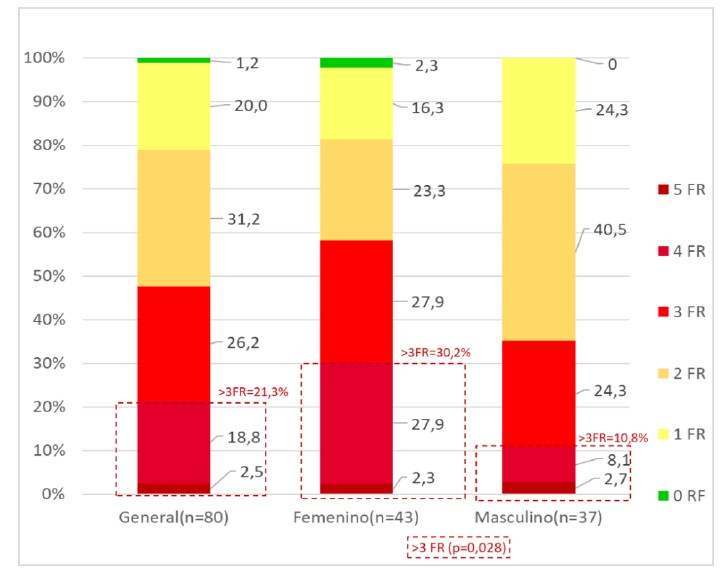Bronchiolitis in a Referral Hospital evaluation of risk factors, etiology and clinical outcomes
Main Article Content
Abstract
Introduction: acute bronchiolitis is a common disease with a high rate of hospitalization.
Objective: to analyze the clinical characteristics, risk factors, and viral etiology in children under 18 months of age hospitalized for acute bronchiolitis at a referral hospital.
Methodology: this was a descriptive, retrospective and correlational study of 80 infants under 18 months of age with acute bronchiolitis, hospitalized in the Pediatric Emergency Department of the National Hospital, from July/2021-September/2022. Infants of both sexes with a positive nasopharyngeal swab for respiratory viruses were included, excluding those hospitalized in other
wards. Sampling: was non-probabilistic for convenience. The data were analyzed with EPI INFO7: for qualitative variables, absolute and relative frequencies were calculated, and for quantitative variables, median and interquartile range. To compare the continuous quantitative variables, the Mann-Whitney test was used, for the qualitative variables the Chi2 test, establishing a significance level of p < 0.05.
Results: a total of 80 infants were included, median age: 2 months (IQR: 1-6), 53.75 % male. Risk factors were: age less than 3 months, 52.5 %, absence of exclusive breastfeeding 51.2 %, malnutrition 41 %, immunodeficiency 38.5 %, prematurity 37.5 %. The most frequent complications were pneumonia (40 %) and dehydration (11.2 %), the most frequent viruses were
respiratory syncytial virus (78.4 %) and adenovirus (17 %). 80 % had severe bronchiolitis.
Conclusions: acute bronchiolitis was more frequent in male children under 3 months of age. The most prevalent etiological agents were respiratory syncytial virus and adenovirus, the most observed complication was pneumonia. 80 % had severe forms.
Article Details

This work is licensed under a Creative Commons Attribution 4.0 International License.
References
Manti S, Staiano A, Orfeo L, Midulla F, Marseglia GL, Ghizzi C, et al. UPDATE - 2022 Italian guidelines on the management of bronchiolitis in infants. Ital J Pediatr. 2023;49(1):19. doi: 10.1186/s13052-022-01392-6
García García ML, Korta Murua J, Callejón Callejón A. Bronquiolitis aguda viral. Protocdiagn ter pediatr [Internet]. 2017[citado 17 de octubre de 2023];1:85-102. Disponible en: https://www.aeped.es/sites/default/files/documentos/06_bronquiolitis_aguda_viral_0.pdf
Fauroux B, Hascoët JM, Jarreau PH, Magny JF, Rozé JC, Saliba E, et al. Risk factors for bronchiolitis hospitalization in infants: A French nationwide retrospective cohort study over four consecutive seasons (2009-2013). PLoS One. 2020;15(3):e0229766. doi: 10.1371/journal.pone.0229766
Jeong JS, Kim JS, Yeom SW, Lee MG, You YS, Lee YC. Prevalence and comorbidities of bronchiolitis in adults. Medicine (Baltimore). 2022;101(25):e29551. doi: 10.1097/MD.0000000000029551
Friedrich F, Ongaratto R, Scotta MC, Veras TN, Stein RT, Lumertz MS, et al. Early Impact of Social Distancing in Response to Coronavirus Disease 2019 on Hospitalizations for Acute Bronchiolitis in Infants in Brazil. Clin InfectDis.2021;72(12):2071-2075.doi: 10.1093/cid/ciaa1458
Luarte-Martínez S, Rodríguez-Núñez Astudillo P. Validez y confiabilidad de la escala de Tal modificada en niños chilenos. Estudio multicéntrico. Arch Argent Pediatr 2019;117(4):e340-e346. doi: 10.5546/aap.2019.e340
Mareco Herrero CM, Insaurralde Báez RE, Lezcano Peralta C, Mareco Herrero CM, Insaurralde Báez RE, Lezcano Peralta C. Manejo inicial de la bronquiolitis aguda grave en el Hospital Central del Instituto de Previsión Social entre enero a junio 2019. Rev. cient. cienc. salud. 2020; 2(2): 11-18. doi: 10.53732/rccsalud/02.02.2020.11
Núñez F, Arbo-Sosa A. Factores de riesgo de Bronquiolitis en pacientes menores de 2 años. Rev. Inst. Med. Trop. 2020;15(1):29-36. doi: 10.18004/imt/202015129-36
Hon KL, Leung AKC, Wong AHC, Dudi A, Leung KKY. RespiratorySyncytial Virus isthe Most Common Causative Agent of Viral Bronchiolitis in Young Children: AnUpdated Review. CurrPediatr Rev. 2023;19(2):139-49.doi: 10.2174/1573396318666220810161945
Cano-Garcinuño A, Praena-Crespo M, Mora-Gandarillas I, Carvajal-Urueña I, Callén-Blecua MT, García-Merino Á. Heterogeneidad de criterios en el diagnóstico de bronquiolitis aguda en España. AnPediatr (Barc). 2019;90(2):109-17. doi: 10.1016/j.anpedi.2018.07.004
Montejo M, Sánchez A, Paniagua N, Saiz-Hernando C, Benito J. Reducción de la tasa de incidencia de bronquiolitis aguda y de las hospitalizaciones asociadas a la enfermedad, durante la pandemia de COVID-19. AnPediatr (Barc). 2022;96(6):537-9. doi: 10.1016/j.anpedi.2021.07.012
Guitart C, Bobillo-Perez S, Alejandre C, Armero G, Launes C, Cambra FJ, et al. Bronchiolitis, epidemiological changes during the SARS-CoV-2 pandemic. BMC Infect Dis. 2022;22:84. doi: 10.1186/s12879-022-07041-x

